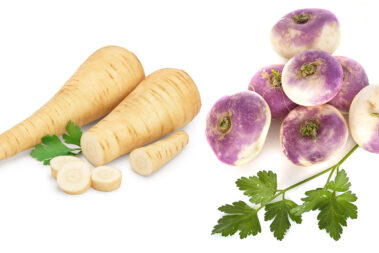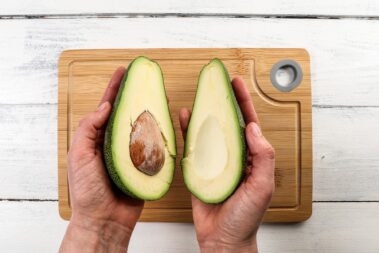If you’ve ever wondered what the difference is between tempeh and tofu, you’re not alone. These two soy products share much of the same characteristics and can be used interchangeably in many dishes. But there are also some key differences between these products, especially when it comes to nutritional content.
This begs the question: Which is better for you, tempeh or tofu?
In this article, we’ll look at how each of these plant-based proteins is made and how they’re used in cooking. We’ll also take a deep dive into their nutritional content and health benefits to figure out which one is better for you.
Table of Contents
What Is Tofu?
Tofu is a soy product made from condensed soy milk curd. These curds are coagulated with nigari, a nutrient-rich salt brine, and formed into dense white blocks.
These blocks are available in five different firmness varieties: silken tofu, soft tofu, firm tofu, extra-firm tofu, and super-firm tofu.
Silken tofu varieties are processed before curdling and retain much more moisture than firmer types. This variety does not hold its shape well and is often used to thicken sauces or add texture to desserts.
On the other end of the spectrum is super-firm tofu. This variety has a higher protein content and much less water than the other types. The firm texture makes it easy to work with since it holds its shape, but it can dry out quickly during cooking.
Tofu has been around for thousands of years and was likely first created during the Han Dynasty in China. As the story goes, a Chinese chef accidentally curdled soy milk by adding nigari to it, and a new way to enjoy soybeans was born.
What Is Tempeh?
Tempeh is another soy product, but one made from whole soybeans rather than soy milk. The soybeans are cooked and fermented then pressed into a firm block or patty. The fermentation process, which is accomplished using the fungus Rhizopus oligosporus, helps break down the phytic acid in the beans which makes the final product more digestible.
Unlike tofu, tempeh comes in one basic type, though you can find varieties with extra ingredients added to them. These extra ingredients usually consist of different grains or seeds to help add to the product’s texture.
Tempeh has also been around for thousands of years. Unlike most other popular soy meat alternatives, this one didn’t come from China or Japan; it came from Indonesia. The best evidence points to the island of Java as the stage for the original creation.
Today, the Javanese still enjoy tempeh, often sauteed with garlic and then deep-fried.
Is Tempeh or Tofu Better for You?
Despite being made from the same plant, tempeh and tofu have some differences in nutritional content.
Tempeh is a better source of protein with about twice as much plant-based protein per serving compared to tofu. It also has considerably more fiber. Plus, it’s substantially higher in fat which means it has more calories overall than tofu.
Both are good sources of iron, manganese, magnesium, and phosphorus. They each provide calcium as well, though tofu provides about five times as much as tempeh.
While the differences in micro and macronutrient content of tofu and tempeh are notable, the overall health benefits of these foods are similar.
Health Benefits of Tofu and Tempeh
Both tempeh and tofu make up part of a healthy diet and are valuable protein sources for plant-based diets. They are both considered a complete protein and contain all essential amino acids. And they each are better for you than animal protein.
Soy is most famous for being high in isoflavones, a type of phytochemical that mimics estrogen. Both tempeh and tofu are loaded with these isoflavones and both have been linked to a decreased risk of breast cancer in women(1) and prostate cancer in men(2).
A diet high in soy has been linked to a decreased risk of stomach cancer, as well(3).
Both diets high in tofu and tempeh have been linked to a lowered risk of cardiovascular disease and more normal blood pressure. While a diet high in any kind of legume shares these benefits, one high in soy specifically appears to provide extra protection against vascular disease and heart disease(4).
Soy products can also help you lose weight and get better control over your blood sugar. Tofu, even more so than tempeh, is a great choice for those looking to reduce their calorie intake as it has about 25% fewer calories. Plus, it is lower in fat.
But tempeh has its own advantages. As a fermented food, it has the potential to positively influence gut microflora, especially if eaten raw or lightly cooked. It also has a lot more fiber than tofu which can help with regularity, weight loss, and balancing the gut biome.
Which One Is Healthier?
As a vegan protein source, tofu and tempeh are each excellent choices. Minimally processed soy products like these are rich in protein and nutrients.
However, tempeh contains more protein and fiber, so it will make your meals more filling. Fermentation also makes tempeh easier to digest and may impart some additional gut health benefits. But tempeh can also have a “funky” taste that not everyone will like, and tofu is less expensive and easier to find.
My recommendation? If you like the taste of tempeh and are able to find it easily, then it’s your best choice. However, tofu is still a great option – but consider having larger portions of tofu so that you’re getting plenty of protein with your meals.
How to Use Tempeh in Your Cooking
Tempeh is most often eaten cooked, though pasteurized tempeh is perfectly safe to eat raw. It has a bit of a bitter flavor and is fairly tough, however. Even when cooked in recipes, many suggest steaming the product first to help soften it up and make it more absorbent to the flavors of the dish.
Like other soy-based meat substitutes, tempeh is a great option for marinating, sauteing, and grilling. But make sure you slice it thin when going these routes. Tempeh is very dense and can be overly tough if cut into too thick of pieces.
The unique texture of tempeh also makes it a good candidate for crumbling into stews, chilis, and pasta sauces. In most cases, you’ll want to cook it with some spices and oil first. Tempeh has a naturally nutty flavor but an overall bland flavor profile, so this step is important to inject some character into the dish.
Learn more about cooking tempeh here, and check out our favorite tempeh recipes below.
- Smokey Tempeh Bacon
- Vegan Sloppy Joes with Tempeh and Lentils
- Walnut and Tempeh Vegan Tacos
- Vegan BLT Sandwich with Tempeh
- Loaded Vegan Nachos
How to Use Tofu in Your Cooking
The key to cooking tofu is, first, to make sure you have the right kind of tofu for your needs. Silken tofu and soft varieties are best for mixing into sauces, scrambles, and batters, or for use in delicate savory recipes. Firmer types are great for recipes where the tofu needs to hold its shape.
In most cases, you’ll want to start your tofu preparation by pressing your tofu block. This involves layering the block with clean towels or paper towels and then using something heavy, like a pan, to slowly force the water out of the bean curd. Alternatively, you can use a tofu press.
Once your block has been pressed, you can easily cut it into slices or cubes for sauteing, searing, grilling, or baking. Even more so than tempeh, tofu has a very neutral flavor and requires marinating or seasoning. It will happily accept the flavors of the dish, so long as you press it first and give it time to soak up any juices.
You can also eat tofu raw. In fact, some delicious appetizers use raw tofu as their star ingredient. To learn more about using and cooking tofu, check out this article.
Here are a few of our favorite tofu-centric recipes:
Homemade Baked Tempeh or Tofu
Looking for an easy yet awesomely delicious recipe that can be used for either tofu or tempeh? We’ve got you covered. Our baked tempeh or tofu recipe is perfect for those looking to cook either of these great soy products for the first time.

Baked Tempeh (or Tofu)
Ingredients
- 8 oz tempeh cut into cubes
- ¼ cup soy sauce
- 2 tbsp rice vinegar
- 2 tbsp maple syrup
- 1 tbsp olive oil extra-virgin
- 1 tbsp sriracha
Instructions
- In a small bowl, combine soy sauce, rice vinegar, maple syrup, olive oil, sriracha, and black pepper. Place the tempeh in a shallow container and pour the marinade over the top. Alternatively, mix your tempeh and marinade in a ziplock bag. Leave it to marinate for 30-60 minutes.
- Preheat the oven to 425°F and line a baking sheet with parchment paper. Spread the cubes on the baking sheet, reserving the rest of the marinade.
- Bake for about 10 minutes, then remove the tempeh from the oven and brush the leftover of the marinade onto the cubes. Bake for 10 more minutes, and enjoy!








